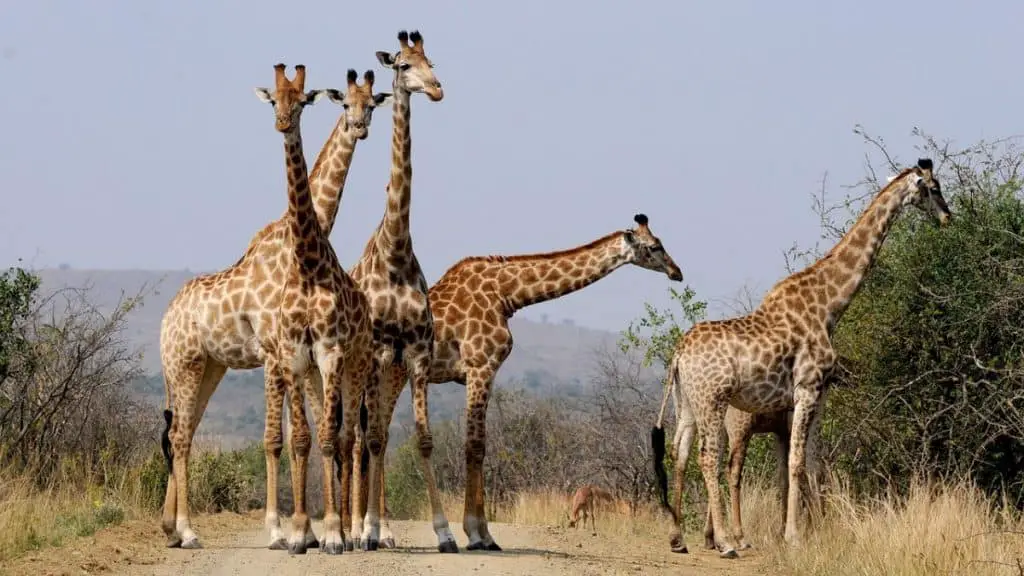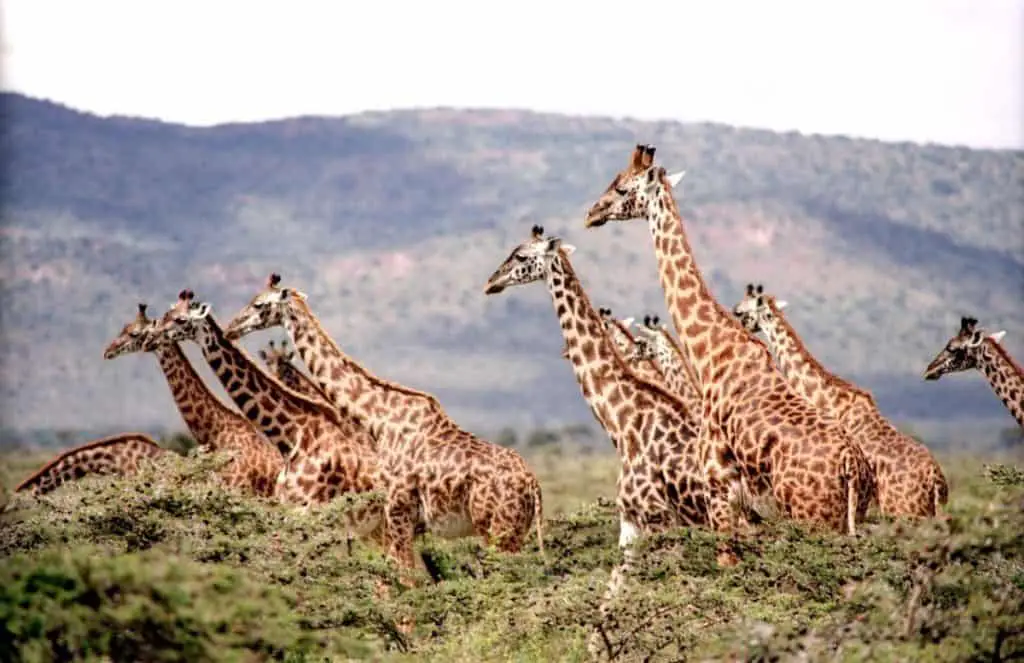Scientists are doing tremendous work to feed us with knowledge of every possible living animal. One of my favourite animals is also the tallest, the giraffe, so in this article, I will look at how good their senses are and how they see, smell, and hear the world.
Giraffes do not have many predators but still have the usual prey senses. Giraffes have excellent eyesight and hearing and a keen sense of smell to detect danger. Giraffes do not have a good sense of taste as they lack taste buds on the tongue.
If you want to learn about how good each giraffe’s senses are, please take a few minutes and read through this article. I have provided you with all you might need to know about the five senses of a giraffe.
Do giraffes have horns or antlers? The answer may surprise you.

Sight
A giraffes’ height plays a significant role in how good their eyesight is. Giraffes are among the few animals that can boast excellent sight, and there are reasons for this.
- Eye location
A giraffe has two eyes on each side of the head. Each of the eyes bulges out slightly, giving them one of the best types of view; a panoramic peripheral vision. The greater an animal’s peripheral vision is, the better it can see the environment around, helping it watch out for any danger without turning its head. With this eye location, a giraffe has a very high panoramic view.
- High vision acuity and light-sensing cells
Giraffes live in a wide and open space, giving them a great view of their surroundings. Their high visual acuity offers them a great advantage to thrive in this environment.
Furthermore, they have light-sensing cells with a unique arrangement. These specially arranged light-sensing cells permit them to be able to see their feet and a few meters ahead of them at the same time while walking. These light-sensing cells also help giraffes see objects close to their eyes during foraging.
- Colour vision
Giraffes do not eat any leaves and fruits during foraging. Colour vision helps them distinguish between ripe and unripe fruits and fresh, good-looking leaves and bad ones.
- Monocular and binocular vision
At a young age, giraffes have monocular vision (when they use each of their two eyes independently). Monocular vision gives a poor perception (focus) but a wider field of view. However, their vision gradually changes from monocular to binocular as they age.
The field of view becomes smaller with age but gives better focus. Sight is the most predominant sense that a giraffe possesses. Giraffes can spot an object about a mile away, so their eyesight is excellent.
Do you know how many species of giraffe there are? Find out here.
Taste
The organ responsible for taste in every animal is the tongue. However, the tongue on its own cannot do the tasting without taste buds. Most vertebrates have taste buds on their tongue, but giraffes are different.
Though the giraffe’s tongue is large and long, it possesses no taste buds. Giraffes taste using the rear part of the roof of the mouth. Taste is the poorest sense among the five senses of a giraffe.
Giraffes have a very large and long tongue ( 45cm-55cm), about 15 times longer than the human tongue. The tongue has a dark tip and is covered with melanin.
The melanin helps protect the tongue against sunburn since the tongue is often outside foraging for food.
Do you know how giraffes defend themselves? Find out here
Touch
Giraffes have a large massive body build-up of thick muscles. The mammal has skin consisting of living cells lined with blood vessels giving it a keen sense of touch. As it explores its environment looking for food, it rubs its body against objects along its path.
Sharp objects might likely wound the animal, but they use their sense of touch to discover bushes and trees that may damage them.
Their bodies are covered with thick hair that prevents injuries to the animals. Giraffes will use their prehensile tails to drive away flies, showing that the giraffe can feel it once a fly lands on its body. This confirms that giraffes have a good sense of touch through their skin.
Did you know that giraffes give birth standing up? Find out more facts here
Smell
Giraffes generally have a very good sense of smell. The sense of smell helps them to detect predators from a far distance and be able to escape or find ways to avoid the predator.
Giraffes also use the sense of smell during mating. When the male wants to find out if the female is ready for mating, it rubs at the posterior part of the female until she passes out urine. The male then smells the odour to decipher whether or not the female is on heat.
The sense of smell is also used when feeding. Giraffes use their noses to differentiate ripe from unripe fruits.

Hearing
Hearing is one of the most used senses for giraffes in times of danger and during mating. Giraffes have large ears and are good at understanding differences in sounds coming from their kind. It is known that during mating, the male makes a coughing sound to attract females. Typically, when you hear a male giraffe make this coughing sound, do not mistake it for signs of unwellness as it is a way to attract females.
When there is apparent danger, especially when the youngsters have strayed away from their mother, the mother makes a hissing or whistling sound which the youngsters pick up. The youngsters then run to their mother for protection at any of these sounds.
Even when two giraffes are out of sight, one will make a sound signalling the other about its presence.
Giraffes, therefore, have a good sense of hearing which is to their advantage. While giraffes are often mistaken for being shy, they make many sounds. Because of their excellent hearing, they do not need to be loud and can remain undetected from predators.
Conclusion
Giraffes are often seen as shy, quiet, and very sensitive animals- having all the five senses like other mammals. Though they don’t have as many predators as some animals, they have good sensory adaptations that help them watch out for predators. These sensory adaptations also help them when finding a mate.
A giraffe’s sense of taste is not well developed as they lack the usual taste buds. As an analogy, humans have about 10000 taste buds on their tongues while the cart fish has more than 100000 ( the animal with the highest number of taste buds). This comparison gives us an idea of how poorly developed giraffes’ sense of taste is.
